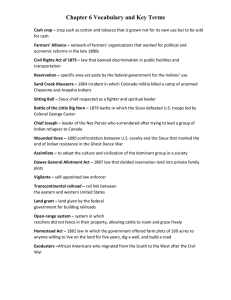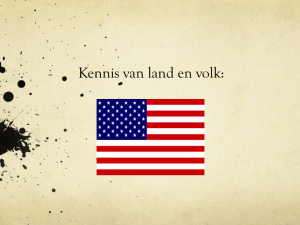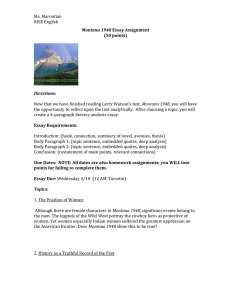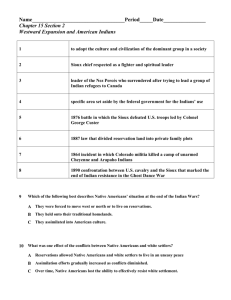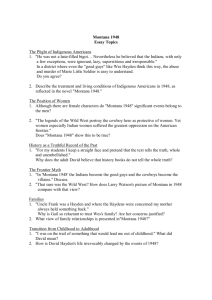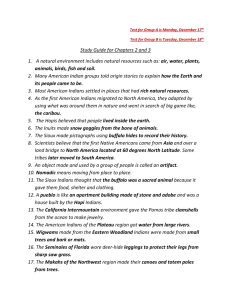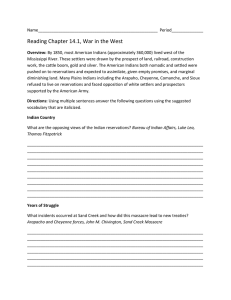montana 1948
advertisement
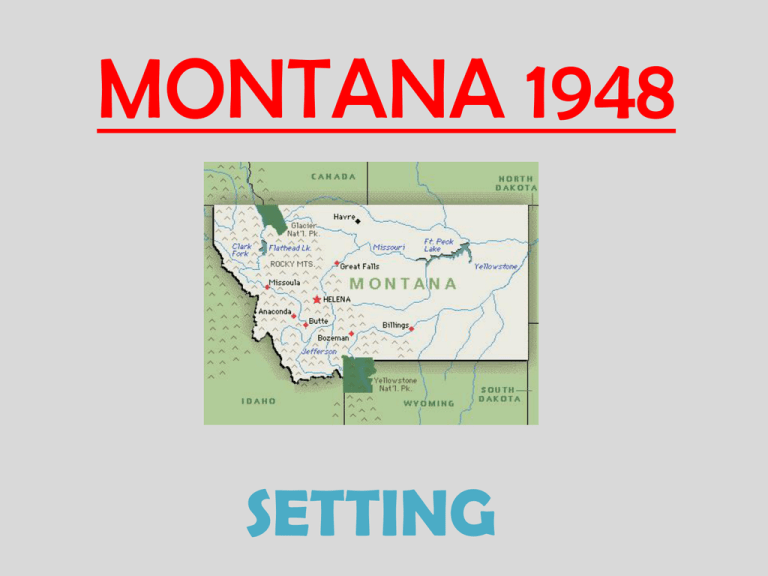
MONTANA 1948 SETTING Write as much as you can for each of the following questions…try and think of examples! • How is the ‘harsh life’ demonstrated? • Why is there so much description given to Bentrock and its location? • What is the importance of the year 1948? • What promises does the year 1948 hold? • What is the importance of the Indian reservation? MONTANA • Located in the middle of the North American continent. • Huge state with contrasting regions; flat, treeless plains and unrelenting winds sweep its Eastern parts, while the Rocky Mountains tower over the Western part. • Extreme climate BENTROCK • • Fictional community (Larry Watson says: “Bentrock is a town that exists only in my imagination. I grew up in North Dakota and had family in Montana, so Bentrock resembles the small towns on the prairie that I visited (and lived in) as a child”. • Small town – controlled in many ways by the Hayden family • Town of Bentrock described as “hard country-the land is dry and sparse and the wind never stops blowing. The heat and thunderstorms in summer can be brutal, and the winters are legendary for the fierceness of their blizzards and the depths to which temperatures drop”. This description of the town could be seen as symbolic of struggle. The setting mirrors the struggles the Hayden family have to deal with throughout the course of the story, paralleling the experiences shared and the emotions felt by the central characters. Description of Montana p15-16 • Montana is a hard place. The young David lived with his parents in Mercer County in the middle of nowhere. It is farm and ranch country where people have to work hard to survive. He describes Fort Warren Indian Reservation nearby as an even harsher territory left to the Indians ‘the rockiest, sandiest, least arable parcel of land’. He speaks of his childhood home with ‘brutal’ summers, fierce winters, endless wind and few trees on the tabletop plain. We already get a feel for the country and how David sees it. Even though life is hard, his empathy with this country is felt. Post-war Montana was ‘blessedly peaceful’. People were happy with their mundane lives. Key scene in text: Don’t blame Montana (p175) • When David’s wife Betsy asks Wes and Gail at Thanksgiving dinner about the ‘Wild West’, Wes slams his fist on the table and yells “Don’t blame Montana...don’t ever blame Montana!” • Even after all the years have passed, Wes still suffers greatly with what happened in 1948. However, it is not the State which is to blame, it is the people and he is one of the people. The wounds are still deep and tender. THE YEAR 1948 • This year is shortly after World War II; people were still recovering from the war, doing the best they could to survive and flourish. • This year is some time before the Civil Rights movement. (Truman is president, re-elected over Thomas Dewey, and two more presidents served before Johnson came and passed the Civil Rights Bill) • Because of this, 1948 was a time when civil rights amongst minorities were ignored, and this was true with many Native Americans. In 1948, a lawyer really wouldn’t defend a Native American in court. In Montana during this time, a court would probably not even accept a case involving a Native American. • The book was set in 1948 because it was a time when discrimination and oppression happened freely; with no law in place to stop it. It was also a time when the law was not developed enough to really prosecute for the kind of wrong doing addressed in the text. If it was set today, lawyers would be involved, along with harsh sentences, politics, money and ethics. There would be provisions in place to ensure that family members are not in a position where they need to deal with each other on a professional basis (as Wes and Frank did). Key scene in text: The wood still vibrates (p175) • After the dinner, David sits at the table. He can still feel the wood vibrating from his father’s blow. This symbolises that even after time passes and everything looks settled and forgotten, the pain and trauma of past events can reverberate through present lives and have the same stomach wrenching effects they had years before. For David, the summer of 1948 will never be forgotten, nor will the pain it caused to the people that he loved. “COWBOYS & INDIANS” • The Indians were an underclass kept in their place (as much as possible) by the whites. • Were treated as “ignorant, lazy, superstitious and irresponsible.” • There was terrible fighting for land and resources. There were many peace talks and bargains struck and many unscrupulous people tricked the Indians into giving up their land. Because of this, the Indians became the underclass victims of the white man’s superiority. We see this clearly in the text through: • The way Julian, Frank and Wes speak of the Indians and treat them • Julian continued to be the cowboy who had to demonstrate his power over the oppressed group. • Frank abused their women • Wes just thought badly of them, and didn’t speak up until he absolutely had to. History of Sioux Indians • Sioux is pronounced “Su” and means “little snakes”. • Historically, by the early 19th Century, the Great Sioux Nation dominated most of the Northern Plains, including parts of Montana. They were put into reservations (mostly in the Black Hills and South Dakota), with the US government’s promise to keep white men out of their territory. Despite this, ten years later, gold was discovered in the Black Hills and the Sioux land was invaded. There continues to be a struggle for the Black Hills. Sioux today • Early Sioux schools tried to take away the children from the adults. The children were forced to think and act like the white man. They were often punished for speaking their own language. • Today about 30,000 Sioux live on reservations in South Dakota. There are also small reservations in North Dakota, Nebraska, and north-eastern Montana. Many have been forced to move to cities to find work. • Most reservation housing is poor. They live in wooden cabins that rarely have hot and cold running water or electricity. Despite their difficulties, the Sioux Indians still have hope. They strive to preserve traditional ways. Sioux in the text: • David becomes more and more aware of the status of the Indians. Those who live on the Reservation are treated badly and discriminated against by the ordinary citizens of Bentrock. Indians like Ollie are liked because they try to be white and are accepted. Ollie may not be happy because he is caught between who he really is and who he is trying to be. • We cannot fully understand the impact of the summer of 1948 in Bentrock, Montana carefully unless we understand the plight of the American Indians and those who victimise them. Key scene that represents this: • The Indians have gathered on Circle Hill (p101-102) • David dreams about the Indians from the Reservation on Circle Hill to mourn Marie. David is afraid that the Indians might/should seek revenge on the people of Bentrock. Really, this implicitly refers to the tragedy of the American Indians. They are the oppressed minority and are unable to seek the justice they deserve. David sees them dressed like ordinary people – having lost their rich heritage. They are not ready to come down to the town with war cries as in the movies, but are just ‘milling about’. They are impotent in bringing about any justice for Marie or themselves. They have no one to fight for them, and cannot fight for themselves. Setting question…. • How does the setting of the novel – the time, place, and the presence of the Sioux – contribute to the events that happen during the summer of 1948? • Setting is time and place AND social situation. • The time – 1948 • The place – Montana • The social situation? The North American Indian population were treated poorly by racist white laws and discrimination and oppression were commonplace. • How does all of this add up to the terrible things that happened in the story? Write an essay with 4 paragraphs: • How does the setting of the novel – the time and place, contribute to the events that happen during the summer of 1948? • Introduction – fill in the gaps… The text ___________ by _________ ____________ is set in _________, _____ in the year _______ . This setting helps us to understand the reasons behind the events that took place. Paragraph 1 • The time – When did the story take place? Find some quotes that support your answer. What attitudes did the different groups of people have to each other at the time? Give some examples from the text. How does this help us understand what happened? Paragraph 2 • The place – Where was the story set? Find some quotes that support your answer. How did the surrounding area and the location (isolation) affect what happened to the people? How did it affect their behaviour? Give some examples from the text. Conclusion • The reasons for the __________ events that happened in the novel ____________ by ________ __________ have a lot to do with the setting. Events such as ______________, ___________ and __________ can be linked to the time and the place the story occurred. This helps us to understand ______________________. Remember to use quotes from the text to back up your ideas!
